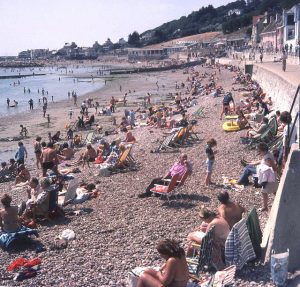22 January 2019
Two- to three- fold increase in heatwave occurrence and severity seen directly in UK temperature records
Posted by Nanci Bompey
By Peter Thorley
A two- to three-fold increase in heatwave activity in the United Kingdom since the late 19th century has been identified in a new analysis of historical daily temperature data.
Scientists from the Department of Physics at the University of Warwick and at the London School of Economics examined data from the Central England Temperature (CET) record, the longest available instrumental records of temperature in the world.
Their results show that although heatwaves have occurred in the past, their frequency, duration, and severity have increased. The analysis, published in Geophysical Research Letters, a journal of the American Geophysical Union, is a new take on one of the few continuous, long term temperature time-series in existence.
The conclusions do not rely on identifying and counting heatwaves directly but instead use observations of daily temperatures to show how the likelihood of different temperatures has changed. By applying a method called crossing theory to these probabilities, the scientists have provided information on the changing relationship between frequency, duration and intensity of heatwaves. This allows for more robust statements about how climate change has affected the characteristics of the heatwaves we experience.
Heatwaves are by definition rare events and estimating their likely severity and frequency based on the past is a challenge. However, as hotter days become more frequent, heatwaves become more likely and longer lasting on average. This work quantifies the link between more frequent observations of hotter days, and increased heatwave occurrence rates, intensity and average duration
As there are several definitions for heatwaves, this work defines a heatwave as a number of successive days where the maximum daily temperature is above a threshold. The threshold of interest depends on what is societally important, so 28 degrees Celsius (82 degrees Fahrenheit), the UK guidelines for the overheating of buildings, is useful for analyzing the Central England Temperature record, but in a hotter country a higher threshold would be more relevant.
By focusing on occurrences of higher temperatures, the researchers could identify changes in the occurrence of heatwave activity over time and the proportion of time spent in a heatwave. For heatwaves at temperatures exceeding 28 degrees Celsius, they found a two- to three-fold decrease in the average return period (the average time between two successive occurrences) of a six-day long heatwave and a two-to three- fold increase in the duration of a heatwave with an average five year return period. The temperature threshold of a six day long heatwave with five year return period has increased, to being typically above 28 degrees Celsius.

A 2-3 fold increase in heatwave activity since the late 1800s is found in the Central England Temperature record. Crossing theory provides estimates of average heatwave properties from the observed cdf. These are plotted versus time in years, where a heatwave is defined as consecutive days with maximum summer daily temperatures above a threshold. For heatwaves at a threshold of 28 degrees C, the UK threshold for building overheating, we see a 2-3 fold decrease in the return period of a 6 day long heatwave (panel a) and a 2-3 fold increase in the duration of a heatwave with an average 5 year return period (panel b). The temperature threshold of a 6 day long heatwave with 5 year return period has increased, from being typically below 28 degrees C to typically above it (panel c).
Credit: AGU
When studying recent heatwave activity, climate scientists will often use computer models. This study provides an additional method, based upon observational data, that complements established methods and will provide scientists with a baseline with which to compare recent heatwave activity.
Lead author Professor Sandra Chapman from the University of Warwick said: “Heatwaves are by definition rare events, so that putting numbers on their frequency, duration and severity is a challenge. However, as hotter days become more frequent, heatwaves will on average become more likely and longer lasting and if we have the data, this is something we can quantify.
“How these temperature extremes are changing may not simply follow changes in the average temperature. We have seen intense heatwaves in the UK several times before, but at the same time we see heatwaves becoming more intense and severe on average,” she added.
— Peter Thorley is a media relations manager at the University of Warwick. This post originally appeared as a press release on the University of Warwick’s website.



 GeoSpace is a blog on Earth and space science, managed by AGU’s Public Information staff. The blog features posts by AGU writers and guest contributors on all sorts of relevant science topics, but with a focus on new research and geo and space sciences-related stories that are currently in the news.
GeoSpace is a blog on Earth and space science, managed by AGU’s Public Information staff. The blog features posts by AGU writers and guest contributors on all sorts of relevant science topics, but with a focus on new research and geo and space sciences-related stories that are currently in the news.